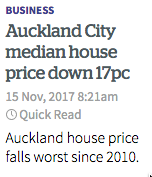Summarising house prices
From the Herald (linking to this story)
To begin with, “worst” is distinctly unfortunate now we’ve finally got a degree of political consensus that Auckland house prices are too high. “Best” might be too much to hope for, but at least we could have a neutral term.
More importantly, as the story later concedes, it’s more complicated than that.
It’s not easy to decide what summary of housing prices is ideal. This isn’t just about mean vs median and the influence of the priciest 1%, though that comes into it. A bigger problem is that houses are all individuals. Although the houses sold this October are, by and large, not the same houses that were sold last October, the standard median house price summary compares the median price of one set of houses to the median price of the other set.
When the market is stable, there’s no real problem. The houses sold this year will be pretty much the same as those sold last year. But when the market is stable, there aren’t interesting stories about real-estate prices. When the market is changing, the mix of houses being compared can change. In this case, that change is the whole story.
In Auckland as a whole, the median price fell 3.2%. In the old Auckland City — the isthmus — the median price fell 17%. But
Home owners shouldn’t panic though. That doesn’t mean the average house price has fallen by anything like that much.
The fall in median has been driven largely by an increasing number of apartments coming onto the market in the past year.
That is, the comparison of this October’s homes to last October’s homes is inappropriate — they aren’t similar sets of properties. This year’s mix has many more apartments; apartments are less expensive; so this year’s mix of homes has a lower median price.
The story does admit to the problem with the headline, but it doesn’t really do anything to fix it. A useful step would be to separate prices for apartments and houses (and maybe also for townhouses if they can be defined usefully) and say something about the price trends for each. A graph would be a great way to do this.
Separating out changes in the mix of homes on sale from general house price inflation or deflation is also helpful in policy debates. Changing the mix of housing allows us to lower the price of housing by more than we lower the value of existing houses, and would be valuable for the Auckland public to get a good feeling for the difference.
Thomas Lumley (@tslumley) is Professor of Biostatistics at the University of Auckland. His research interests include semiparametric models, survey sampling, statistical computing, foundations of statistics, and whatever methodological problems his medical collaborators come up with. He also blogs at Biased and Inefficient See all posts by Thomas Lumley »

Hi Thomas
Changes as you suggest need to be made, but of course that would make them more factual and less able for journalists to use the ‘bait’ headlines they used.
7 years ago
“A useful step would be to separate prices for apartments and houses (and maybe also for townhouses if they can be defined usefully) and say something about the price trends for each”
Like, say, I don’t know, maybe how the data can be extracted from the QV website by property type: https://www.qv.co.nz/property-trends/residential-sales-prices
I really worry about the state of journalism in this country
7 years ago
Also, see https://mbienz.shinyapps.io/urban-development-capacity/ for a a sale price SPAR index
7 years ago